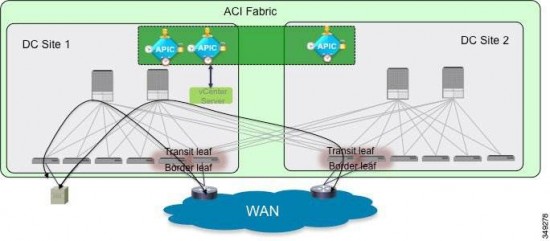In the world of Cisco ACI, there is never a shortage of excitement and action. Today, we are pleased to bring to your attention news about the latest Cisco APIC software release. If you wonder what’s hot of the press in APIC SW release 1.0(3f) for Nexus 9000 series ACI mode, there are quite a few.
The Stretched Fabric feature captures the headlines. For quite some time now customers have been asking for an ACI Fabric that can stretch across datacenters and over long distances. The new software allows for each leaf and spine, that participate in creating a fabric, to be located up to 30 KMs apart. It also removes the restriction for every leaf to be connected to all spines. Let us take a close peek at the stretched fabric feature.

Stretched ACI fabric is a single fabric. It is a partially meshed design that connects ACI leaf and spine switches distributed in multiple locations. Typically, an ACI fabric implementation is a single site where the full mesh design connects each leaf switch to each spine switch in the fabric. This yields the best throughput and convergence. In multi-site scenarios, full mesh connectivity may be not possible or may be too costly. Multiple sites, buildings, and rooms can span distances that are not serviceable by enough fiber connections, or are too costly to connect each leaf switch to each spine switch across the sites. Diagram below illustrates the stretched fabric architecture.
Transit Leaf Switch Guidelines
Transit leaf refers to the leaf switches that provide connectivity between two sites. Transit leaf switches connect to spine switches on both sites. There are no special requirements and no additional configurations required for transit leaf switches

The key benefits of stretched fabric include workload portability and VM mobility.The stretched ACI fabric behaves the same way as a regular ACI fabric, supporting full VMM integration. For example, one VMWare vCenter operates across the stretched ACI fabric sites. The ESXi hosts from both sites are managed by the same vCenter and Distributed Virtual Switch (DVS). They are stretched between the two sites.
The ACI switch and APIC software recover from various failure scenarios. Check out the failover scenario analysis for details.
Additional resources
https://www2.wwt.com/video-aci-active-active-demo/
Interesting technology news, I am glad to hear it.
Thanks a lot, Ravi for sharing this. Very informative.
Hi Ravi,
Great article. Would like you to expand a bit more on the VM mobility, such as data stores and data replication between sites. I guess I am asking about what other considerations there are to give the VM mobility story a more complete narrative in the ACI context.
Thanks
Satvinder
Ravi, I read the additional resource link. Question? Do we have a documented tested configuration for First Hop Routing Localisation via FabricPath?